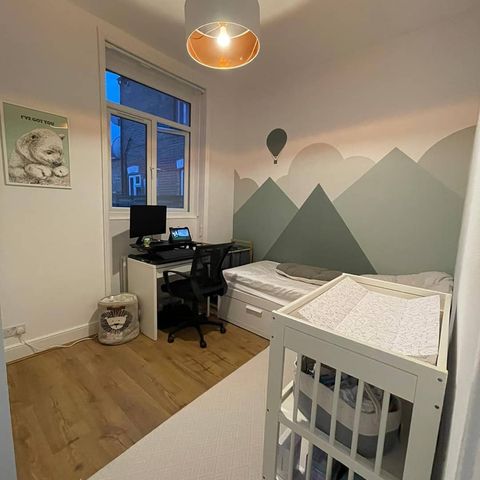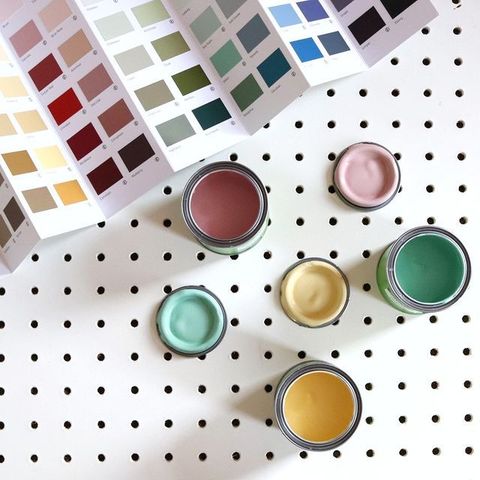Child safe paint: Improve air quality and prevent damp and mould
Why children's rooms are at risk from pollution and chemicals
Remarkedly, we spend one third of our lives in our bedrooms , a living space that can have the worst air quality of any room in our homes. Unknowingly, the bedroom can be full of allergens, dust mites, scents, and chemicals- all of which can trigger allergies and asthma. Possible sources are mattresses, household pets, carpets, chemical cleaning agents, aerosols, mould from condensation and damp clothing in connecting en suite bathrooms. Running the air vent for 15-20 minutes after using the shower in addition to fixing leaks from washrooms can help prevent damp and mould.
If you work outside or in polluted cities, changing clothing outside of the bedroom will help to avoid cross contamination and bringing pollutants into your bedroom. We all enjoy scents and sprays, however, even pleasant scents like candles, plug in air fresheners and potpourri can cause asthma symptoms. "Most of the things that cause problems are odourless" says Dr Nicholas Busaba, associate professor of otolaryngology at Harvard Medical School, "So in many cases there is nothing to alert you to the problem except the symptoms these allergens can trigger such as respiratory problems, digestive issues, lethargy, sleeplessness and fatigue".
Nowadays many buildings are tightly sealed, meaning very little fresh air gets in and air pollutants can linger. To get rid of them, keep your home well-aired. But remember that outdoor air pollution can also travel inside. Check your local outdoor air pollution levels regularly and consider avoiding opening windows at times when the Daily Air Quality Index is high or very high. New furnishing, particularly mattresses and rugs, can release volatile organic compounds (VOCs). It's these VOC'S which contribute to respiratory illnesses and exacerbate existing asthma.
Damp issues and health concerns
In the United Kingdom, a large percentage of our building stock is old, and we know the weather can be wet and cold throughout the year, so care must be taken to prevent rooms getting damp and mould growing. Damp leads to condensation, which encourages mould and other fungi to grow. Lots of things can cause this, damaged pipes, steam from bathrooms and showers, poor heating and ventilation. Condensation is more likely to happen in cold places in your household around windows or rooms with external walls, there are different types of damp sources:
- 'Penetrating damp' is caused by moisture coming into the house through leaking or cracked pipework, a damaged roof, blocked guttering, gaps around window frames and cracked or defective rendering and brickwork.
- 'Rising damp' is due to a defective (or non-existent) damp course. This will leave a 'tide mark' about a metre above the floor. Newly built homes can sometimes feel damp because the water used during its construction is still drying out.
The correlation between damp and respiratory problems
If your home's damp, you might have an irritated nose and throat, or feel short of breath. If you have asthma, your symptoms may get worse. It's common to have an allergy to moulds. One fungus often found indoors is called aspergillus. It can cause a wide range of conditions, from mild irritation of your airways to more serious infections if you have a lung condition.
If you currently have damp or mould issues to deal with, we recommend reading this article before attempting repairs yourself.
How to reduce damp causing condensation in children's bedrooms
Many properties, particularly older ones, suffer from damp. One previous remedy was to attempt to seal the walls to make them waterproof, using non-breathable building materials and paints such as vinyls. Whilst this offered a short-term solution, water naturally finds its way in through hairline cracks in the walls, as the building moves. Once the water has penetrated the wall it has no escape and becomes trapped beneath the waterproof material and paint work, resulting in rising damp in the walls. Any paints that contain vinyl, acrylic, oils or plastics are not breathable and can trap moisture beneath the surface, causing mould, decay, then ultimate breakdown and detachment of larges areas of paintwork.
If you want to find out why older building suffer from damp, take a look at the Old building Eco Handbook to find out where damp comes from and its various manifestations in the home.
Improving air quality without compromising style
Air Purifying Paints contain a molecular sieve which is designed to trap harmful volatile organic compounds (VOCs) as they circulate in our living spaces. The sieve's non-toxic crystalline tubes are designed to filter specific harmful VOCs, including formaldehyde, glycol, carbon dioxide, NOx and SOx. Air Purifying paints are engineered to improve the air quality inside and outside your home, they are based on sustainable natural ingredients.
Damp preventing and child safe?
One way to avoid damp in your kid's bedroom is to use breathable building materials, such as lime render or plaster overcoated with lime based paints. Breathability' refers to how easily water vapour can pass through a medium. For example a breathable wall is one that will take in moisture present in the air, then release it without impacting on the fabric of the building.
GrafClean is a breathable paint that will allow water vapour to permeate, travel and transfer through itself. GrafClean is Class 1 rated breathable coating reducing condensation and damp. It is an ideal ecological sustainable coating for plaster and plasterboard on interior walls and ceilings, it may also be used externally. It is a washable finish particularly suited to busy hallways and humid environments such as bathrooms and kitchens. GrafClean is a natural sustainable wall paint recommended on interior and exterior concrete in new builds as it is certified for moisture control in concrete surface protection systems (EN 1504-2).
How do air purifying paints work?
Based on lime and 100% natural ingredients Avace Graphenstone Air Purity paints absorb CO2 as they cure. Once the paint is applied it commences a process of carbonation, during the first three days one 15 litre container of Ambient Pro+ will absorbs 5.5kg of CO2 , the same amount as an adult tree achieves in four months.
Achieving the industry's highest environmental standards, including Cradle to Cradle Gold, LEED, WELL & BREEAM. Rated Global Green Tag Platinum Graphenstone is the worlds leading environmental brand of mineral paints and coatings. This range of Air Purifying paints are better for the environment and healthier for our homes and cities. A harm free solution for our planet and people with Ambient pro+.
Stuck for style ideas? Take a look at our colour trends for 2021 blog post and get inspired!
Air-purifying paint: Damp preventing and pollution reducing
Interior designers and colour experts have collaborated to create a timeless luxurious paint collection, designed to look beautiful in both traditional and modern homes. Based on natural lime ingredients reinforced with graphene for enhanced flexibility and durability.
Uniquely breathable, these paints reduce damp and condensation, they meet the highest environmental standards for indoor air quality absorbing CO2 and other pollutants. They can be applied to masonry, gypsum , plasterboard and lime based plastered interior walls and ceilings. Combining GrafClean on the walls with Ambient Pro + on the ceilings is a perfect solution to reduce condensation and absorb pollutants in the bedroom.
How do I pick a colour?
GrafClean is available in 96 high design colours. Interior designers will use a strong colour like Periwinkle on a feature wall alongside Mink. Transitional colours are also popular particularly around adjacent living spaces colours link Old Bone and Pale Walnut create a soft and inviting transition from wall to wall. A split wall effect selecting adjacent colours from the pastel tones and mid tones is an emerging trend. A striking divide decorating a lower wall to window in Sandstone and above the sill to ceiling in Wheatberry.
All over cover is the most dramatic effect creating intimate and inviting living spaces selecting a colour like GrafClean Juniper for walls and woodwork contrasted with a Ambient Pro+ White Linen on the ceiling for a natural feel.
Which child safe paint for my kids room?
These combinations are ideal for nurseries, child's bedrooms and play areas. GrafClean is certified "Toy Safe" and Ambient Pro+ is the ultimate in air purification paints.
Learn more about breathable air purifying paint and why it's beneficial for your health and our planet.
Samples, getting a colour chart and expert advice:
- Order a FREE colour chart here
- FREE delivery on orders of 3 sample pots or more
- Have a question about our range? Please don't hesitate to get in touch with our outstanding customer service team, available at sales@avace.co.uk






